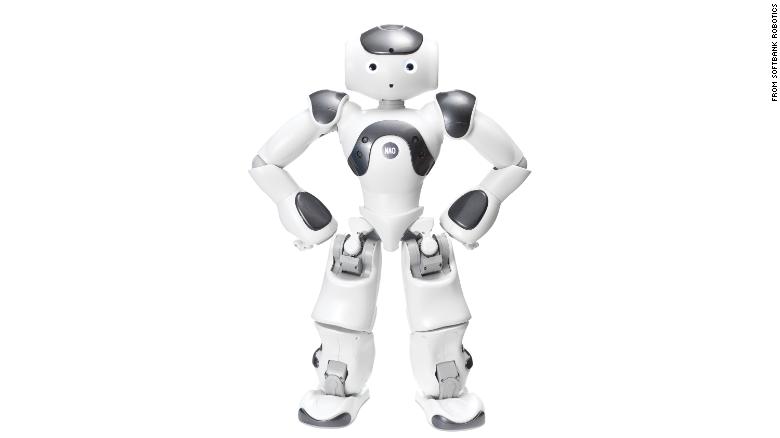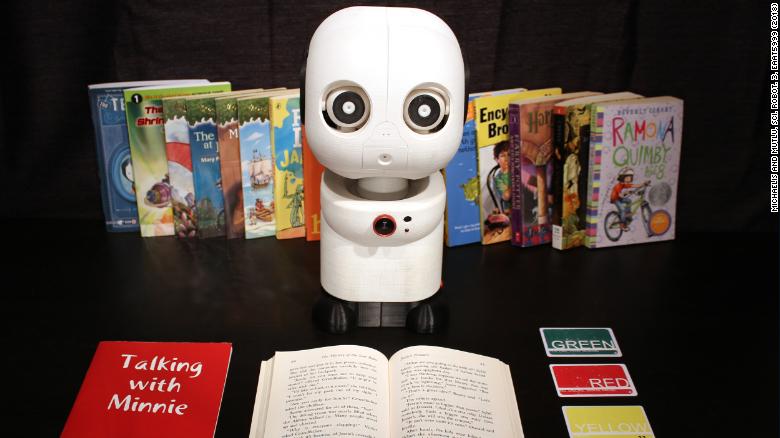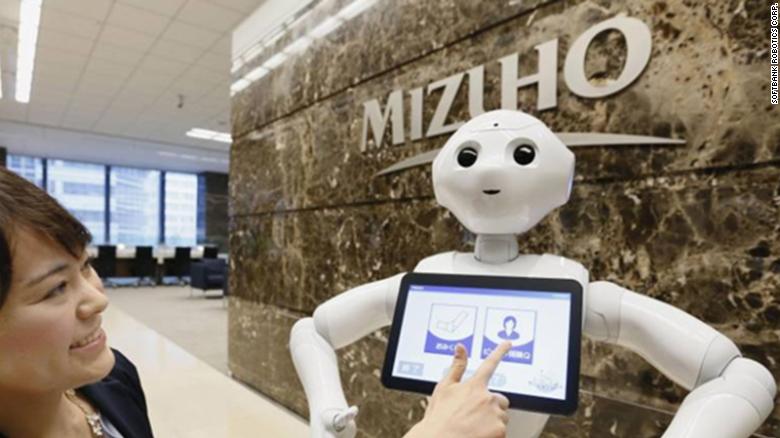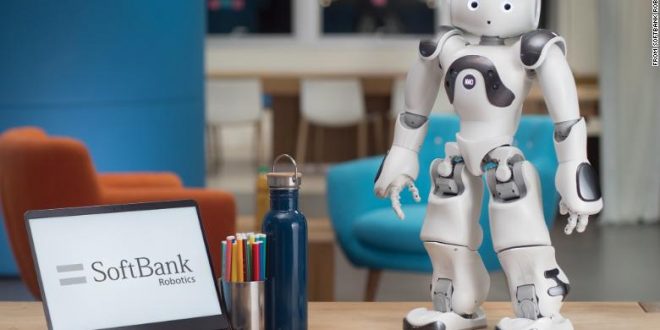For many people, the future inspires nightmare visions of a “robopocalypse,” a time when humans become subjugated by their own creations: robot overlords that possess superior physical and intellectual prowess.
One Japanese researcher, however, has designed a robot that instills the opposite image of our future, particularly in the minds of the children who use them.
Fumihide Tanaka’s educational robots do not perform the role of an all-knowing teacher. Instead, they are built to help young students study English vocabulary and serve as classroom dunces who commonly make mistakes — mistakes that a helpful student can correct.

By teaching a less intelligent robot, children reinforce their own learning and so become stronger students themselves, Tanaka believes, and research supports this.”We learn a lot by teaching others,”said Tanaka, information and systems associate professor in the Faculty of Engineeringat the University of Tsukuba. “I personally did not like the idea of tutor robots. This is the complete opposite of a tutor robot; it’s more like the children’s friend. Or like a younger brother or sister.”
‘Care-giving robots’
Tanaka’s creations fall into the category of “care-receiving robots,” he said. As the name suggests, they require human companions to pay attention and show concern. The original concept was proposed in 2009.
Having developed both entertainment and educational robots as a former research engineer at Sony, Tanaka believed that a care-receiving robot would be ideal as an educational tool. In published research, he and a colleague wrote, “Most educational robots for children so far have been designed and developed to play the role of human teachers or caregivers. In fact, some robots have already been named explicitly as ‘childcare robots.’ ” But Tanaka and his colleagues aimed to turn the child care concept on its head. They designed some of their original experiments around Nao, a SoftBank Robotics humanoid model that is just 25 inches high. When they presented the robot in a classroom of preschoolers, they found that when Nao was programmed to answer all the questions correctly, the children interacted less with their new friend than when it was programmed to make mistakes.
Not only did the robot inspire care-taking in the preschool children, it increased their spontaneous learning: the unplanned and unstructured eureka moments that can widen a child’s worldview. For example, children enjoyed teaching the robot so much that they would repeat the teaching games at home, even though there was no robot there, their parents reported.
Since these early experiments, Tanaka has supervised the development of a commercial educational robot known as Pepper for SoftBank Robotics.
A different experience
In general, robots provide a different educational experience than previously experienced, said Tanaka, who has been working in this part of the robotics field since the early 2000s.
One advantage of educational robots is that they have no set timetable. “Children can play with the robot at any time: at midnight or whenever he or she wants to play with the robot,” he said. “That’s difficult to do with a human or adult teacher.”
Another benefit is that robots are entertaining while holding a child’s interest for sustained periods, studies have found, and this provides motivation to learn, he added.
On top of that, a well-designed robot will not make a child feel “pressured,” Tanaka said, whereas parents and teachers sometimes do. “We can design a robot as a kind of weak existence.” Reassured by the robot’s unimposing presence, a child will want to play and be able to learn easily instead of feeling the kind of pressure that locks a student’s mind.
The subtleties of demeanor and behavior are inherent in designing “social robots,” the broader group of robots of which Tanaka’s care-receiving robots are a part.
‘Social robots’
Joseph Michaelis, a doctoral student in the Department of Educational Psychology at the University of Wisconsin-Madison, explained that social robots “interact with humans using natural social cues like gestures, tone of voice, or head and eye movements to convey meaning.”
“Since humans are so strongly wired to interpret what they encounter in a social way, even simple actions, such as when a robot makes a small movement after a child presses its button, can be perceived as social,” he said.
Michaelis and his colleagues designed a learning companion robot, Minnie, based on principles of social robot design described in a paper published in 2017. Unlike Tanaka’s robots, though, Minnie does not require a child’s care.

Minnie, a learning companion robot, listens and makes occasional comments while children read.
Instead, Michaelis’ team programmed Minnie, who is just 13½ inches high, to respond with thoughtful comments to individual children who read books. “The interaction with the robot and comments that Minnie makes about the books demonstrate some understanding of what is happening in a story but is not presented in an authoritative way,” Michaelis said.
For example, when a child reads a frightening scene to Minnie, the robot might comment, “Oh, wow, I’m really scared,” as if it had a real personality.
Minnie also makes eye contact with the child, averts its gaze when speaking (so as to appear thoughtful) and moves subtly in idle moments to appear more lifelike.
“We want the children to feel they are working together with a peer rather than being taught by a tutor or teacher, and so we design the interaction to be conversational,” Michaelis said.
The hope, as with Tanaka’s robots, is that Minnie can help kids feel greater motivation and ultimately greater autonomy so they will want to learn on their own.
However, Minnie is still in the experimental phase. Michaelis believes that “general-purpose educational robots are a very long way from reality.” First, he speculates, well-designed — if limited — intelligence robots will be introduced into the educational system.
But before that, there are more than a few hurdles to overcome, he said.

Pepper, a Softbank Robotics creation, has been used for commercial applicatons, including acting as a “greeter” in stores.
Parental concerns
According to Tanaka, one of the first questions parents ask is whether the robot poses any safety concerns for their children.
For this reason, he designs his care-receiving robots to be smaller than the children and to appear “weak” and “not harmful. I thought that this is more socially acceptable.” Appearance is important, he said, though it’s unclear how designers can ensure that robots do not frighten young children.
Michaelis noted that “privacy is a huge concern, particularly for parents.”
“Parents want to know what information the robot is collecting, how it uses it and when this information is being collected,” he said. “In our work, we told parents and children that the robot would audio record their reading.”
To ease parents’ minds, Michaelis and his colleagues added a simple LED to indicate to families when the robot was recording. “It is also important to keep in mind that social norms about privacy are different from culture to culture, and the design of a social robot should be sensitive to this,” he said.
Replacing teachers?
The greatest worry for both society and robot engineers, though, is ethical: “Tutor robots tend to be regarded as replacing the human teachers,” Tanaka said.
The fear of losing jobs is real, since robots have reduced the number of employees in other fields, such as auto manufacturing, Michaelis said.
“However, most people in educational robotics, including Fumihide Tanaka, don’t see robots replacing teachers, not even in the long term, but rather as a way of supporting teachers and supplementing curriculum,” Michaelis said. “This support might be especially crucial given the ever-expanding size of classrooms, at least in the US.”
Japan is also looking for new ways to establish an improved system of education.
A recent statement from the Central Council for Education, a body within the Ministry of Education, suggests that it is “becoming increasingly difficult to teach children.” Child poverty, an increasing number of both special-needs students and foreign students, and “bullying, truancy and acts of violence” all contribute to educational challenges, according to a council report — challenges that could be overcome by robotic aids.
In April, Japan’s Ministry of Education, Culture, Sports, Science and Technology will launch a robot initiative on a trial basis at about 500 schools nationwide, as reported by Japan Times. The goal of the initiative: helping children learn English. Tanaka has not been directly involved in the initiative, but this and all other real-world tests of robotic educational theory will inevitably inform future research.
The next trend and an area researchers around the world have begun to explore is group learning, Tanaka said. “So far — and this is not only in Japan — most researchers for educational robots target the one-to-one learning scenario,” he said. He, and other researchers globally, are also investigating the ways in which telepresence robots, which can be controlled from a distant location, can be used in classrooms.
“We ask elderly people in Japan to teach children in elementary school. By using this robot, elderly people can participate in the classroom from their homes,” Tanaka said, suggesting that this use of robots may enrich both classrooms and the lives of older adults. “So distance learning is another project we are working on now.”
Michaelis said he’s “very optimistic” about the role that robots can play in education. “If we get it right,” he said, “educational robots might have the transformational power that personal computers and even calculators had on education.
–
CNN
 UAE BARQ برق الإمارات – نبضك
UAE BARQ برق الإمارات – نبضك



